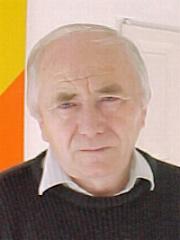
1937 On 9 February he was born in Orosháza
1938 The family moved to Békéscsaba
1944 - 52 A typical bad pupil at primary school. He hated the teachers, who did not allow him to write with his left hand.
1950 - 56 He visited an art circle in Békéscsaba. He was the enthusiastic pupil of József Mokos, a polymath and pedagogue.
1956 - 61 He was admitted to the Decorative Paining Department of the Hungarian Academy of Applied Arts. He graduated with distinction. His teachers were Lajos Szentiványi, György Z. Gács and Gyula Hincz. During his years at the Academy he helped in the elaboration of his teachers' mural paintings.
1961 - 64 He lived and worked together with Gyula Hincz, the rector of the Academy, who became a father-figure and friend, who personality influenced him positively, and it was he mentioned Lajos Kassák to Fajó.
1961 - A member of the Studio of Young Artists.
1962 - 65 He organised exhibitions in the hall of Studio.
1963 - Gyula Hincz and he were dismissed from the Academy of Applied Arts.
1964 - He was elected to the governing body of the Studio. In the meantime he studied aesthetics, the history of art and philosophy.
1964 - 1967 Until Kassák's death in 1967 he was the only pupil of the great master.
1965 - He organised Kassák's exhibition at the Club of Young Artists, as a result of which the Club was closed down.
1966 - He arranged the material for the exhibition Stúdió'66. This was the first occasion on which abstract-geometric works were exhibited
1967 - 1971 He organised exhibitions at the Fészek Club. After his solo exhibition in 1970 he was dismissed.
1968 - Imre Bak, János Fajó, Sándor Molnár and István Nádler published the first Hungarian serigraphs series. The new generation began to assert itself.
1969 - He obtained a passport. He travelled through Western Europe with Kassák's widow. On this journey he became acquinted with Carl László in Basel, Victor Vasarely in Paris and Max Bill at the Constructivist Biennale in Nurnberg. Carl László bought two of his tempera paintings and ordered two other oil paintings, which Fajó painted in Paris.
1970 - Mozgás (Movement) '70, the first exhibition of the group in a museum in Pécs. It was immediately banned.
1974 - The Pesti Mûhely (Pest Workshop), the first free, private workshop was founded with the participation of Imre Bak, János Fajó, Tamás Hencze, Ilona Keserü, István Nádler and András Mengyán.
1976 - The Józsefvárosi Gallery was founded, the first free, non-profit workshop gallery, under Fajó's leadership. The Gallery became an international forum: German, Finnish, Czech, East German, Polish, Russian Austrian, British and Italian artists held exhibitions here.
1976 - 80 The artists spent one month each year at the RÁBA Factory Complex in Gyõr, where Fajó started his sculptural activity. Graphic symposiums were held at the Kner Printing House in Békéscsaba. The Mezõgép factory provided an opportunity for metalworking.
1977 - The beginning of printing activity. The printing house published several portfolios.
1982 - Fajó remained alone in the Pesti Mûhely
1985 - Fajó and Max Bill became friends and worked together. Fajó published Max Bill's portfolio, and they held a joint exhibition at the Ost-West Gallery in Zurich.
1987 - Cooperation between Fajó and Vasarely on the occasion of the publication of the portfolio of the latter.
1988 - He left the Józsefvárosi Gallery because the bureaucracy was hindering his activity.
1990 - Fajó was invited to teach at the Academy of Applied Art.
1992 - He became acquinted with K.F. Binder, a metal manufacturer. Using Binder's factory in Reiherthofen as a base, they founded the Binder Studio in Ingolstadt.
1995 - The village of Bácsborsód, where László Moholy-Nagy was born, invited him to create a centenary memorial monument to the great artist.
1992 - 97 The zenith of his sculptural activity. He bacame famous for his small sculptures in marble, metal, wood, bronze, and acrylic glass.